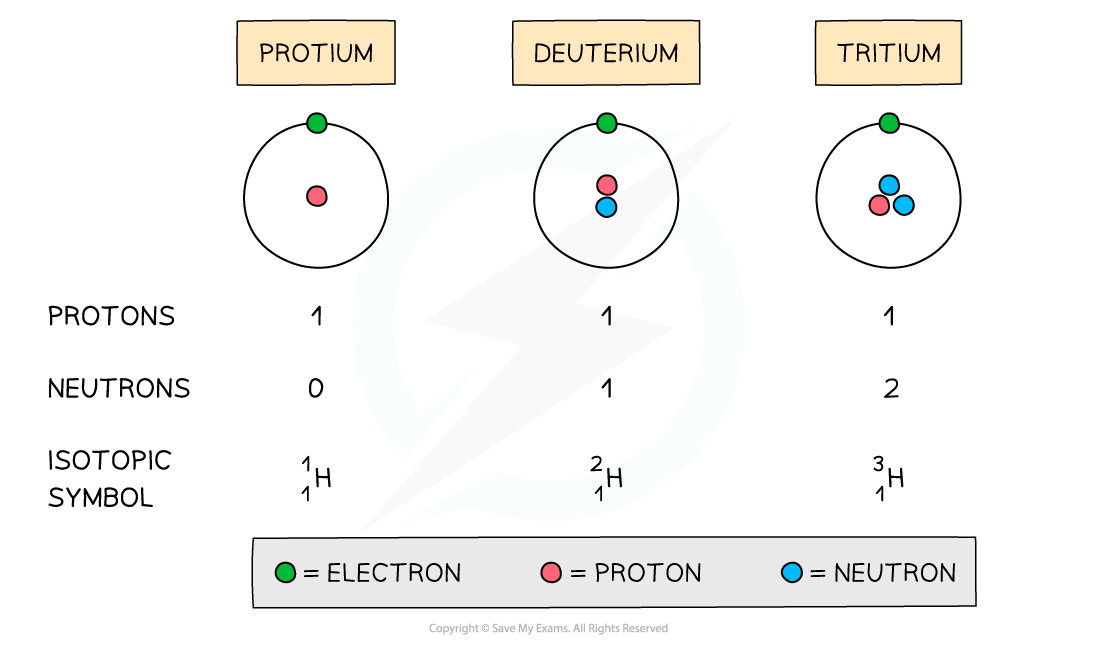- 翰林提供学术活动、国际课程、科研项目一站式留学背景提升服务!
- 400 888 0080
Edexcel A Level Chemistry:复习笔记1.1.2 Isotopes
Atomic Structure Calculations
- An atom is neutral and has no overall charge
- Ions on the other hand are formed when atoms either gain or lose electrons, causing them to become charged
- The number of subatomic particles in atoms and ions can be determined given their atomic (proton) number, mass (nucleon) number and charge
Protons
- The atomic number of an atom and ion determines which element it is
- Therefore, all atoms and ions of the same element have the same number of protons (atomic number) in the nucleus
- E.g. lithium has an atomic number of 3 (three protons) whereas beryllium has atomic number of 4 (4 protons)
- The number of protons equals the atomic (proton) number
- The number of protons of an unknown element can be calculated by using its mass number and number of neutrons:
Mass number = number of protons + number of neutrons
Number of protons = mass number - number of neutrons
Worked Example
Determine the number of protons of the following ions and atoms:
- Mg2+ ion
- Carbon atom
- An unknown atom of element X with mass number 63 and 34 neutrons
Answers
Answer 1: The atomic number of a magnesium atom is 12 indicating that the number of protons in the magnesium element is 12
-
- Therefore the number of protons in a Mg2+ ion is also 12
Answer 2: The atomic number of a carbon atom is 6 indicating that a carbon atom has 6 protons in its nucleus
Answer 3: Use the formula to calculate the number of protons
Number of protons = mass number - number of neutrons
Number of protons = 63 - 34
Number of protons = 29
-
- Element X is therefore copper
Electrons
- An atom is neutral and therefore has the same number of protons and electrons
- Ions have a different number of electrons to their atomic number depending on their charge
- A positively charged ion has lost electrons and therefore has fewer electrons than protons
- A negatively charged ion has gained electrons and therefore has more electrons than protons
Worked Example
Determine the number of electrons of the following ions and atoms:
- Mg2+ ion
- Carbon atom
- An unknown atom of element X with mass number 63 and 34 neutrons
Answers
Answer 1: The atomic number of a magnesium atom is 12 suggesting that the number of protons in the neutral magnesium atom is 12
-
- However, the 2+ charge in Mg2+ ion suggests it has lost two electrons
- It only has 10 electrons left now
Answer 2: The atomic number of a carbon atom is 6 suggesting that the neutral carbon atom has 6 electrons orbiting around the nucleus
Answer 3: The number of protons of element X can be calculated by:
Number of protons = mass number - number of neutrons
Number of protons = 63 - 34
Number of protons = 29
-
- The neutral atom of element X therefore also has 29 electrons
Neutrons
- The mass and atomic numbers can be used to find the number of neutrons in ions and atoms:
Number of neutrons = mass number (A) - number of protons (Z)
Worked Example
Determine the number of neutrons of the following ions and atoms:
- Mg2+ ion
- Carbon atom
- An unknown atom of element X with mass number 63 and 29 protons
Answers
Answer 1: The atomic number of a magnesium atom is 12 and its mass number is 24
Number of neutrons = mass number (A) - number of protons (Z)
Number of neutrons = 24 - 12
Number of neutrons = 12
-
- The Mg2+ ion has 12 neutrons in its nucleus
Answer 2: The atomic number of a carbon atom is 6 and its mass number is 12
Number of neutrons = mass number (A) - number of protons (Z)
Number of neutrons = 12 - 6
Number of neutrons = 6
-
- The carbon atom has 6 neutrons in its nucleus
Answer 3: The atomic number of an element X atom is 29 and its mass number is 63
Number of neutrons = mass number (A) - number of protons (Z)
Number of neutrons = 63 - 29
Number of neutrons = 34
-
- The neutral atom of element X has 34 neutrons in its nucleus
Defining & Calculating Isotopes
- The symbol for an isotope is the chemical symbol (or word) followed by a dash and then the mass number
- E.g. carbon-12 and carbon-14 are isotopes of carbon containing 6 and 8 neutrons respectively
- Isotopes are atoms of the same element that contain the same number of protons and electrons but a different number of neutrons

The atomic structure and symbols of the three isotopes of hydrogen
转载自savemyexams

最新发布
© 2025. All Rights Reserved. 沪ICP备2023009024号-1









